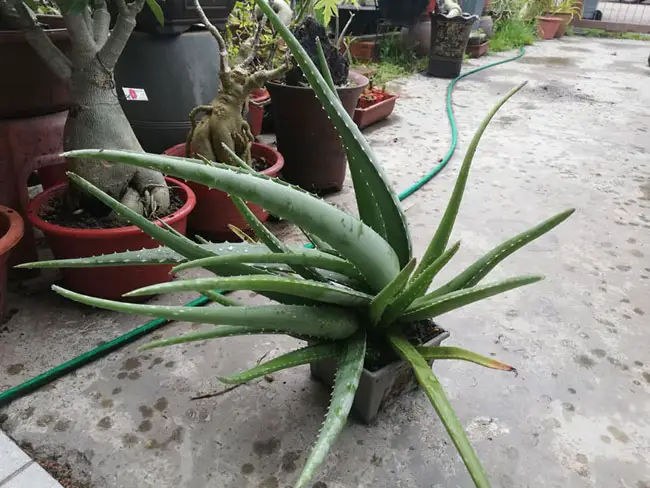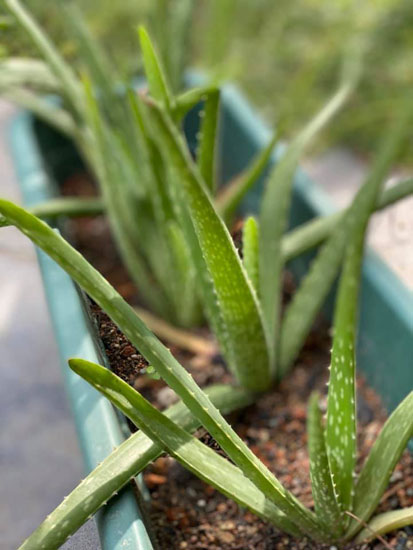If you live in a particularly sunny region, you should consider growing your own aloe plants at home. Aloe plants are the perfect succulent plant for desert climates, as they thrive in light. The gel within their leaves serves as an effective salve to sunburns and skin irritation. Still, aloe plants can be finicky to care for, so it is imperative to know exactly what they require.
Aloe vera plants thrive in poor soil that is coarse and well-drained. These succulent plants also require roughly 6-8 hours of full sunlight a day. Additionally, aloe vera plants will not survive in freezing temperatures, making it challenging to grow them outdoors in more seasonal environments.
While you may be inclined to grow your aloe vera plants outdoors due to their excessive sunlight requirements, it is important to factor in cold weather hazards such as freezing. There are methods to work around freezing temperatures, but they require the know-how and work. Keep reading to learn more on how to care for your aloe vera plant, indoors or outdoors.
Can Aloe Plants Survive Outside?
When considering where to grow your aloe vera plants, you must consider the most optimal locations for their needs. However, it is also essential that you calculate any risks associated with these locations.
Growing your aloe vera plants outside can be extremely beneficial for them. The outdoors will provide your plants with plenty of access to sunlight, which is crucial to the growth of aloe vera plants. Still, there are several dangers to consider when planting your aloe vera plants outside. Here is a list of the dangers to consider when planting your aloe vera plants outside:
Freezing Soil
The primary concern with growing your aloe plants outdoors is their susceptibility to damage in freezing temperatures. There are some temporary workarounds for sporadic, overnight freezes. However, if you live in a region with long-lasting winter seasons, it is best not to grow your aloe vera plants outdoors. This is due to the impact soil freezes will have on your plant.
Too Much Sun Exposure
Another concern with growing your aloe vera plants outdoors is the potential for too much direct sunlight exposure. While aloe vera plants will still grow under direct sunlight, their leaves may turn red or yellow due to an overabundance of sunlight exposure. You can remedy this by planting your aloe vera plants in a slightly more shaded area in your garden or yard.
Insufficient Soil Drainage
Finally, you should also consider the drainage of the soil you grow your aloe vera plant in. This is a concern for both indoor and outdoor aloe vera plants, but some owners may believe that outdoor soil does not need to be treated as much due to rainfall. This is not the case. You should treat outdoor soil with compost, perlite, or weathered pumice and sand.
Additionally, you should water the soil you plan on planting your aloe vera in before doing so. This is particularly necessary if the soil has not experienced rainfall for several months. After doing so, be sure to let the soil dry out again before planting your aloe vera plant.
Can Aloe Plants Live Outside in the Winter?
The short answer to this question is that it depends on where you live and how you can work around any climate-related concerns in your region. Essentially, the first thing you should consider is the general climate of your region.
If you live in a warmer, desert-style climate, then you will generally have nothing to worry about when it comes to keeping your aloe plants outside during the winter. The USDA sorts the various regions in the United States into zones that reflect the region’s general climate. Aloe vera plants are safe to grow outdoors in USDA zones 8 to 11.
The regions in the United States that are included in these zones are most of California, Western Oregon, Western Washington, Southern Nevada, Southwestern Arizona, Texas, Louisiana, Alabama, Mississippi, Georgia, South Carolina, and Florida.
It is unlikely that you will experience freezing temperatures in these regions. However, if you do, there are temporary solutions for overnight freezes, such as covering the plant with a large plastic container or some other shield against the cold.
If you do not live in one of the regions included within USDA zones 8 to 11, then it is advised that you do not grow your aloe vera plants outside during the winter. There are temporary salves for week-long freezes that involve spreading a thick mulch or straw around the aloe vera plant’s root base to protect its roots from freezing.
However, your best bet is to bring your aloe vera plant inside for the winter.
How to Grow an Aloe Plant Outdoors
Regardless of what kind of climate you live in, the summertime is generally an excellent time to grow your aloe vera plant outdoors. Whether you live on the West Coast or in rural Nebraska, these practices generally remain the same. So, let’s take a look at the general procedures for growing your aloe vera plant outdoors:
- Pick the Right Soil: Aloe vera plants do well in poor soils coarser and rockier than most soils found in gardens. You can certainly install a layer of poor soil in a designated region in your backyard. However, the simplest way to grow an aloe vera plant is in a pot, whether indoors or outdoors.
- Pick the Right Pot: To grow your aloe vera plant optimally, you should purchase a terra cotta bowl with a drainage hole at the bottom. This will keep your soil well-drained, which it must be to grow your aloe vera plant properly.
- Pour in the Soil and Plant your Aloe Vera: Once you have picked suitable soil, succulent mixes are available on Amazon, and the right pot, you are free to plant your aloe vera. Once you plant it, you should refrain from watering it for at least a week to prevent rot. Then, water your plant once every other week.
How to Care for an Aloe Plant
Whether you choose to raise your aloe vera plant indoors or outdoors, you must take the proper steps to care for it once it has been planted. Let’s take a look at the general steps to caring for an aloe vera plant, whether it is located indoors or outdoors:
- Indirect, Bright Sunlight: Keep your aloe vera plant in locations with bright but indirect sunlight. Artificial light will also suffice.
- Moderate Temperatures: Aloe vera plants thrive in temperatures ranging from 55 degrees Fahrenheit to 80 degrees Fahrenheit. This may seem quite moderate for a desert plant, but this makes the aloe vera plant the perfect plant to keep outdoors in desert climates during all seasons as temperatures can dip below 60 at night.
- Water Thoroughly, But Infrequently: Finally, be sure to water your aloe vera plant deeply, but make sure not to do so too often. You should water your aloe vera plant roughly once every 2 to 3 weeks in the summer and even more sparingly during all other seasons.
Final Thoughts
By the end of this article, you should know a bit more about how to care for your aloe vera plant, indoors or outdoors. Ultimately, the most important thing for your aloe vera plant is to keep an eye on it. While it does not need frequent care, it does not respond well to extreme temperatures or conditions, so it is vital to protect it in those instances.



